Dubrovnik Croatia – Best Place To Visit In Croatia
Published: February 3rd, 2019
Author: Mate I
Dubrovnik, Croatia is one of the best known tourist destinations in Croatia, a seaport and center of Dubrovnik-Neretva County in South Dalmatia.
Population Of Dubrovnik Town is 42,615 according to census from 2011.
The beginnings of tourism in Dubrovnik Area are related with the construction of the Hotel Imperial in Dubrovnik in 1897.
Dubrovnik is on the list of the top 10 best preserved medieval walled cities in the world.
According to some historical lores, Dubrovnik was founded in the 7th century on a rocky island named Laus, which is said to have provided shelter for refugees from the nearby city of Epidaurum.
In 1979, the city of Dubrovnik joined the UNESCO list of World Heritage Sites.
Page Content:
Interesting facts about Dubrovnik Croatia
Well-being of the city of Dubrovnik was historically based on maritime trade and well skilled diplomacy.
As the capital city of the Republic of Ragusa, a maritime republic, the city Dubrovnik achieved a high level of development, particularly during the 15th and 16th centuries.

And in that time became notable for its wealth and skilled diplomacy.
Republic of Ragusa received its own Statutes as early as 1272, statutes which, among other things, codified Roman practice and local customs.
The Statutes included prescriptions for town planning and the regulation of quarantine.
Ragusa Republic as a pioneers of civil rights
The Dubrovnik Republic was an early adopter of what are now regarded as modern laws and institutions: a medical service was introduced in 1301, with the first pharmacy, still operating to this day, being opened in 1317.
First almshouse was opened in 1347, and the first quarantine hospital (Lazarete) was established in 1377.
Slave trading was abolished in 1418, and an orphanage opened in 1432.
A 20 km aqueduct system was constructed in 1436.
Republic Of Ragusa was ruled by the local aristocracy which was of Latin-Dalmatian extraction and formed two city councils.
They maintained a strict system of social classes.
The republic abolished the slave trade early in the 15th century and valued liberty highly.
The city successfully balanced its sovereignty between the interests of Venice and the Ottoman Empire for centuries.
Due to the fact that they valued freedom above all, Dubrovnik was a refuge site to many foreigner nation. Many Conversos, Jews from Spain and Portugal, were attracted to the city.
In May 1544, a ship landed there filled exclusively with Portuguese refugees, as Balthasar de Faria reported to King John.
During this time there worked in the city one of the most famous cannon and bell founders of his time: Ivan Rabljanin (Magister Johannes Baptista Arbensis de la Tolle).
Foreign policy of Dubrovnik Republic
Already in 1571 Dubrovnik sold its protectorate over some Christian settlements in other parts of the Ottoman Empire to France and Venice.
At that time there was also a colony of Dubrovnik in Fes in Morocco.
The bishop of Dubrovnik was a Cardinal protector in 1571.
Cardinal protectors were only in 16 other countries, too, in 1571, namely in France, Spain, Austria, Portugal, Poland, England, Scotland, Ireland, Naples, Sicily, Sardinia, Savoy, Lucca, Greece, Illyria, Armenia and Lebanon.
They also had huge navy fleet with around 180 ships which were trading from Byzantine on the east to todays England on the west.
Skilled diplomacy was a crucial factor in maintaining the freedom of Dubrovnik Republic.
They had around 85 consulates scattered in all major world political centers.
Despite the fact that town was demilitarised in the 1970s to protect it from war, in September of 1991, after the breakup of Yugoslavia, Dubrovnik city was besieged by the Yugoslav People’s Army (JNA) for seven months and received significant shelling damage.
The patron saint of Dubrovnik
The patron saint of the city is St. Vlaho (Saint Blaise), whose statues are seen around the city.
St. Vlaho has an importance similar to that of St. Mark the Evangelist to Venice.
One of the larger churches in city is named after Saint Blaise.

February 3-rd is the feast of St. Vlaho, who is the city’s patron saint. Every year the city of Dubrovnik celebrates the holiday with Mass, parades, and festivities that last for several days.
Places to visit in Dubrovnik Croatia
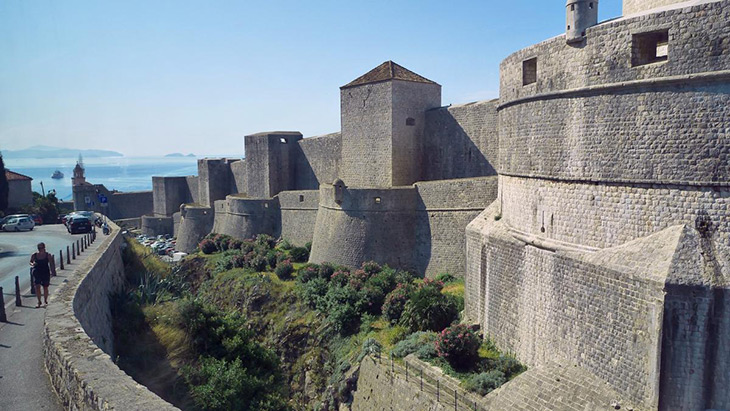
Dubrovnik City Walls
Main trademark of Dubrovnik is its walls that run almost 2 km around the city.
The walls run from four to six meters thick on the landward side but are much thinner on the seaward side. The system of turrets and towers were intended to protect the vulnerable city.
The walls of Dubrovnik have also been a popular filming site for HBO’s Game Of Thrones, who use the walls as filming location for the fictional city of Kings Landing.
Walls of Dubrovnik (Dubrovačke gradske zidine) are a series of defensive stone walls that have surrounded and protected the citizens of the afterward proclaimed maritime city-state of Dubrovnik (Republic of Ragusa).
Located in southern Croatia, since the city’s founding prior to the 7th century as a Byzantium castrum on a rocky island named Laus (Ragusia or Lave).
With numerous additions and modifications throughout their history, they have been considered to be among the greatest fortification systems of the Middle Ages, as they were never breached by a hostile army during this time period.
In 1979, the old city of Dubrovnik, which includes a substantial portion of the old walls of Dubrovnik, joined the UNESCO list of World Heritage Sites.
This complex structure, amongst the largest and most complete in Europe, protected the freedom and safety of a “civilised” and “sophisticated” republic that flourished in peace and prosperity for five centuries.
The walls were reinforced by three circular and 14 quadrangular towers, five bastions (bulwarks), two angular fortifications and the large St. John’s Fortress.

Land Walls were additionally reinforced by one larger bastion and nine smaller semicircular ones, like the casemate Fort Bokar, the oldest preserved fort of that kind in Europe.
The moat that ran around the outside section of the city walls which were armed by more than 120 cannons, making superb city defense.
Dubrovnik city walls have been preserved to the present day, not only because of the knowledge of the skilled construction workers and the constant care provided by city dwellers that maintained and rebuilt the structures as needed, but also because of the brilliantly reputed diplomacy in Dubrovnik, which managed on many occasions to avoid dangerous measures taken by enemies against the Dubrovnik Republic.
Todays irregular parallelogram shape of the walls was defined in the 14th century after the city gained its full independence from Venetian suzerainty, but the peak of its construction lasted from the beginning of the 15th century until the latter half of the 16th century.
Being constructed very solidly, the walls were generally unaffected by a strong earthquake occurring in 1667.
The largest stimulus for continued development and emergency repairs and works of the Dubrovnik fortresses came as a result of the danger of unexpected attack by Ottoman Empire military forces, especially after they conquered Constantinople in 1453.
The city was also under latent danger of attack by the Venetians. For centuries the people of Dubrovnik were able to preserve their city-republic by skillful maneuvering between East and West.
A strategic treaty with Turkey protracted Dubrovnik’s liberty and maintained the opportunity for a major trading role between the Ottoman Empire and Europe.
Town gates of Dubrovnik
Dubrovnik town has four city gates: two that goes to the harbor and two that lead to the mainland.
During the time period when the Austrian Empire controlled the city, two more gates were opened in the wall.
Connection with the outside world on the mainland was maintained with the city through two main well-protected city gates, one placed on the western side of the city and the other placed on the eastern side.
These entrances were constructed so that communications with the city could not be carried out directly; the messenger had to enter through multiple doors and walk down a winding passageway.
This is evidence of the security measures taken as a last defense against the possibility of a surprise breach or entrance of unexpected visitors.
Pile Gates
Pile Gates: well-fortified complex with multiple doors, defended by Fort Bokar and the moat that ran around the outside section of the city walls.

At the entrance gate to the Old Town, on the western side of the land walls, there is a stone bridge between two Gothic arches, which were designed by the esteemed architect Paskoje Miličević in 1471.
That bridge connects to another bridge, a wooden drawbridge which can be pulled up. During the republican era, the wooden drawbridge to the Pila.
Gate was hoisted each night with considerable pomp in a ceremony which delivered the city’s keys to the Ragusa rector.
Today, it spans a dry moat whose garden offers respite from crowds.
Above the bridges, over the arch of town’s principal gateway, there is a statue of city patron St.Vlaho, with a model of the Renaissance city.
After passing the Pile Gate’s original Gothic inner gateway, it is possible to reach one of a three access points to the city walls.
Ploče Gate
Inner Ploče Gate (Gate of St Luka) – according to the nearby church. Those doors are really small, their breadth is only 2m (7 ft).
They are built in Romanesque style, with the main arch stone carved with a Romanesque head of patron of Dubrovnik, St. Blaise.
Over the doors proudly stands high fortress Asimon.
Next to these gates new larger gate is located.

Outer Ploče Gate – dates back in 1450 made by Simeone della Cava, and towards the 19th century the gate were widened. As already mentioned the outer gate bridge was built according to the prototype of Pile bridge by Ivan of Siena.
Gate of Buža (Hole gate)
Buža is located on the northern side of the land walls.
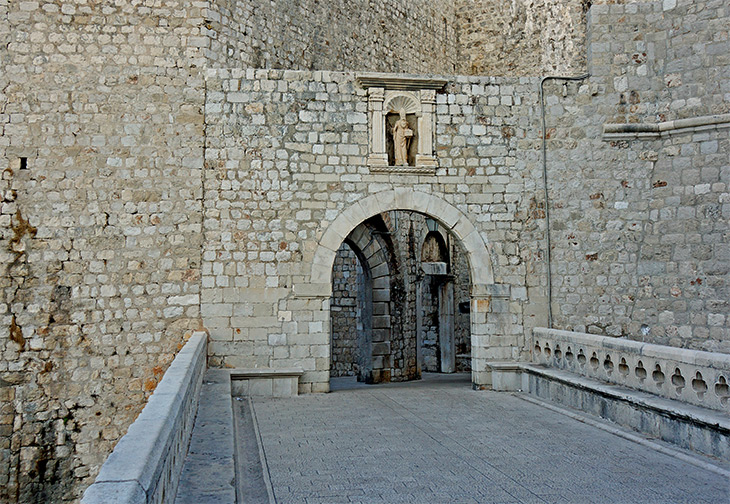
This gate is relatively new compared to the other gates, as it was constructed during the early 1900s.
Fort Lovrijenac
Lovrijenac Fort – located on the west of the Old City on a 37 metre-high rock.
Lovrijenac is symbol of Dubrovniks survival and freedom, the fort was used for the defence of the city and the western Pile gate.
Above the entrance to the fort is the famed inscription: NON BENE PRO TOTO LIBERTAS VENDITUR AURO (Freedom is not sold for all gold in the world).

The first official records mention the fort in 1301, although it is believed that its construction began earlier.
Today Fort Lovrjenac is well-known as one of the Dubrovnik Summer Festival open-air venues particularly suitable for works by William Shakespeare.
Among the finest actors who appeared here in the role of the unfortunate prince of Denmark are Rade Šerbedžija, Daniel Day Lewis and Goran Višnjić.
Placa or Stradun
Placa or Stradun – main open-air public space of Dubrovnik, the favourite promenade and meeting place, the venue of all great festivities and processions.
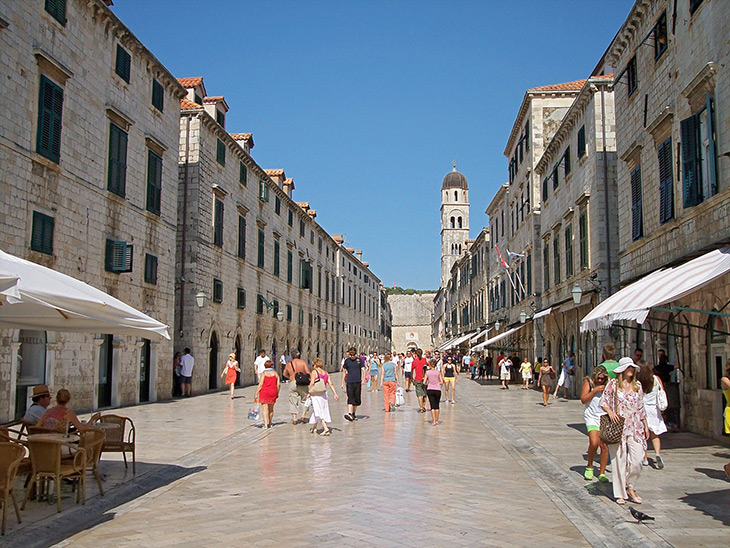
Stradun is the main shopping area and the widest and most beautiful street which divides the Old City into its northern and southern part.
Its origins go back to the 11th century, when the people filled up the shallow sea channel which separated the one time Islet of Lave and a settlement on it from the land where another settlement existed.
Placa acquired its proper function in the late 12th century when both settlements were joined into one urban unit by a city wall complex.
The name Placa comes from the Latin term “platea communis”, denoting the venue of all major public events. The second name Stradun has a Venetian origin and means a large street.
The Large Onofrio Fountain
The Large Onofrio Fountain stands at the eastern end of Stradun.

It was named after the constructor of the 11,7- kilometre long Dubrovnik water supply system from the 15th century, which supplied the stone city with water from the village of Šumet located in the Dubrovnik hinterland.
A second, small fountain which Onofrio della Cava constructed was put up close to the city bell-tower. Today it still feels good to refresh oneself with cool water from the Dubrovnik fountains, while the bell-tower strikes the hours during the hot summer days.
City Bell-Tower with a clock in Dubrovnik
The 31-metre high City Bell-Tower with a clock was built in 1444.
In 1509 the famous foundryman Ivan Rabljanin cast the bell and the green men Baro and Maro.

The Dubrovnik green men on the bell-tower strike on the hour, repeating the striking after three minutes, and also strike on the half-hour.
Between the City Bell-Tower and Sponza Palace is Luža, the old bell-tower, which sounded the convoking of the Dubrovnik Republic council, but also fire and other alarms. Luža was built in 1463, and thoroughly reconstructed in 1952.
The monumental Sponza Palace stands on the left. Built in the Gothic-Renaissance style, it preserved its original form till the present day.
At the time of the Dubrovnik Republic it housed the customs office and storehouses, and was therefore also called Divona (from the word dogana – meaning customs).
Apart from the customs office, the state mint, the exchequer and treasury were also situated at the palace, designed by the Dubrovnik master Paskoje Miličević.
Today the palace is the home of the major cultural institution of the Dubrovnik Archives.
The documents which span the period from the 12th century to the fall of the Dubrovnik Republic which are kept there make this institution one of the most significant archives in the world.
Particularly valuable is the collection of statutory and law books, including the Dubrovnik Statute from 1272. The Dubrovnik Orlando Column is adorned with a statue of the medieval knight holding a sword in his hand.
With a characteristic gothic smile on his face encircled with long curls, he is considered one of Europes handsomest Rolands.
According to the contract from 1418 it was made by Bonino of Milan, with the help of the Dubrovnik masters.
The Orlando Column in Dubrovnik
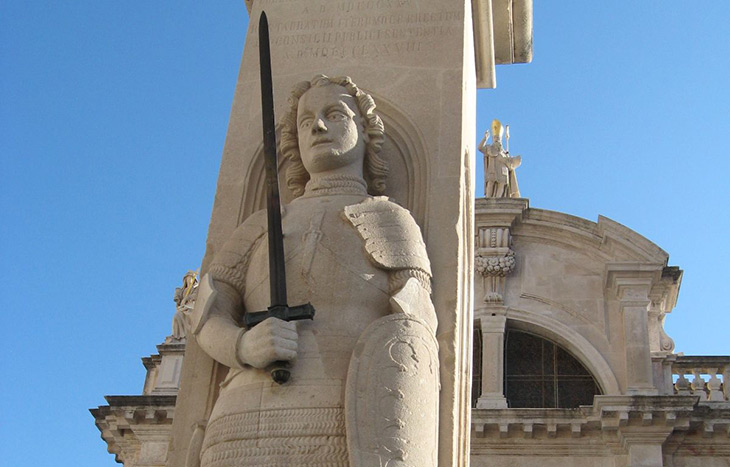
The Orlando Column is the symbol of statehood. On its pole, where the flag of the Dubrovnik Republic once flew, the Croatian national flag now stands.
During the Festival of St Blaise, the Dubrovnik patron saint, the column is bedecked with a flag with his image, and during the Dubrovnik Summer Festival with the Libertas flag.
Lokrum Island, Dubrovnik
Island of Lokrum – first metioned in 1023 it as the venue of the foundation of a Benedictine Abbey and Monastery.
Legend has it that after a shipwreck on his way back from the Crusade in Palestine, Richard the Lionheart found shelter precisely on the Island of Lokrum in 1192.
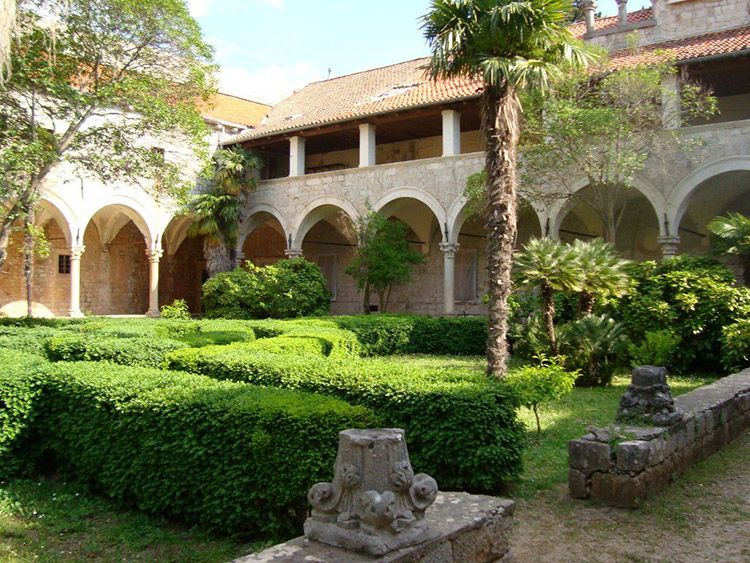
As a sign of gratitude should he be saved, he made a vow to build a church in the place where he would come ashore. However, he fulfilled his vow only in part.
Upon the request of the people of Dubrovnik, Richard the Lionheart provided the money for the continuation of the building of the cathedral within the city.
In 1839 Maximilian von Habsburg visited and bought the Island of Lokrum.
He had his summer residence built on the ruins of the monastery with a magnificent garden, walking paths and promenades. The tradition of gardening and cultivation of exotic plants from the time of the Benedictines via Maximilian von Habsburg until today was continued in 1959, when the Botanical Garden was founded.
The majority of plants were brought from Australia and South America, and the collection of eucalyptuses, cactuses and succulent plants is a special attraction. In 1963 the Island of Lokrum was declared a Natural Reserve and in 1976 a Special Forestry Reserve.
A small lake on the island called Mrtvo More (Dead Sea), connected with the open sea, is suitable for children and non-swimmers. Located on an elevation, the star-shaped Fort Royal, built by the French in 1806, offers a magnificent view of Dubrovnik, Cavtat and the islands.
In only ten minutes, a boat from the Old City Harbour will take you to the nearby Island of Lokrum, a favourite excursion place also known as the Island of Love.
Visit Trsteno Arboretum

Trsteno Arboretum – is the only one on the Croatian Adriatic coast, which combines the rich cultural and natural heritage.
The arboretum, renowned for its historic gardens and a collection of Mediterranean and exotic plants, was founded in 1948 in the area of the summer residence of the Dubrovnik Gučetić-Gozze aristocrat family.
The entire arboretum is a protected monument of garden architecture.
Spreading on over 25 hectares, the comprises a number of different units: the historic Renaissance garden with the summer residence, the historic neo-romantic garden from the 19th/20th century, the historic olive grove and the natural vegetation of the woods of the Downy oak, Alpine pine tree and cypress, as well as the vegetation of macchia and coastal rocks.

In 1494, at the time of the Renaissance, Ivan Marinov Gučetić-Gozze built a summer residence with a garden on his Trsteno estate, which soon became one of the humanistic cultural centres of Dubrovnik.
In this Arcadian idyll, numerous Dubrovnik poets – including one of the most beautiful women of the Croatian renaissance, the Dubrovnik poetess Cvijeta Zuzorić – wrote their verses and had love affairs. One of the arboretum attractions – the garden fountain – was supplied with water by a 70-metre long aqueduct resting on fourteen arches.
In 1736 the former Renaissance fountain was turned into a luxuriant Baroque nymphaeum with the god of the sea and waters Neptune as the central figure in a stone statue group.
Elaphiti achipelago islands

Relied on the city of Dubrovnik and the Dubrovnik Republic, in whose possession they had supposedly been from the 11th century.
According to historic records, the rector of the Islands of Kolocep, Lopud and Sipan was appointed in 1272.
The islands were inhabited from ancient times, a fact which is borne out by the remains of Illyrian buildings and Greek and Roman toponyms.
The commitment to the sea and seamanship improved life conditions on the Elaphit Islands, which flourished during the golden age of Dubrovnik in the 15th and 16th centuries.
Of the thirteen Elaphite Islands only three are inhabited: Koločep, Lopud and Šipan.
You can visit them by old steam ship “Postira” all in one day and enjoy exploring the little old-Croatian churches on the Island of Koločep.
Swim on the sandy beach of Šunj on the Island of Lopud.
Visit the summer residence of the Skočibuha-Stjepović family in Suđurađ and walk the fertile Šipan field covered with olive groves and vineyards, passing by the Rectors Palace, up to the Church of St Stephen in the Luka Šipanska.
The islands boast their own gastronomic delicacies.
The fishermen bring the freshly caught fish from the crystal blue sea, and the taste of ecologically-grown vegetables is enhanced by home-made olive oil.
Art Pavilion Your Black Horizon
Visit the Art Pavilion Your Black Horizon on the Island of Lopud, which has included the island in a tourist-art map of the world.
An obligatory destination for lovers of modern art and summer vacation.
This project was realised thanks to the International Thyssen-Bornemisza Contemporary Art (T-B A21) Foundation presided over by the distinguished modern art collector Francesca von Habsburg.
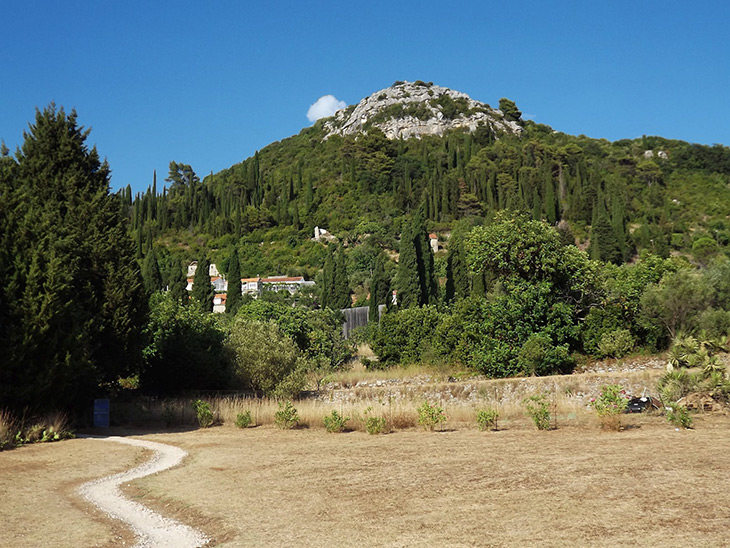
The Art Pavilion Your Black Horizon, which is the joint work of the Danish-Icelandic artist Olafur Eliasson and the London architect David Adjaye, unites art and architecture, and is special primarily for its adaptability to a certain location and its environment.
Take a boat trip to Mljet national park
Mljet island become famous for its stories and legends, the Island of Mljet is the largest island of the Dubrovnik Archipelago and the home of the Mediterranean monk seal.
The island boasts a rich history and archaeological and cultural sites.
The Mljet National Park is situated in the western part of the green island.

A boat ride departing from Gruž harbour will take you to the island, and a ferry connects it with the Pelješac Peninsula.
The port of call on the Island of Mljet is Sobra, and during the tourist season a hydrofoil also operates from Dubrovnik to Polače, from where one can reach the national park by a mini-bus.
One can rent a bicycle or a smaller car on the island, but vehicles are not allowed in the national park.
You will be fascinated by the untouched nature in the park and by the beauty of the Great and Small Lakes connected with the open sea by a narrow channel.
In the middle of the Great Lake stands the Isle of St Mary with the 12th century Benedictine Monastery of St Mary, which can be reached on a small boat.
Do not miss the walks along the lovely wooded paths by the lake. You will take pleasure in the ancient pine forest reaching as far as the lake shore.
In close proximity to the national park is the picturesque little harbour of Pomena, where the only hotel on the island – the Odysseus Hotel – is located.
Pomena is one of the destinations in the famous South-Dalmatian Sailing Regatta which has traditionally taken place on the Dubrovnik-Mljet-Orebic route for many years now.
Take a walk on Srđ highest point of Dubrovnik
Srđ – 413-metre high spot above Dubrovnik and favourite place for taking photographs, Mount Srđ offers a magnificent view of Dubrovnik and its surroundings.

Fort Imperial houses a museum display of the Croatian War of Independence with numerous exhibits including all kinds of weapons and shells which hit Dubrovnik during the bombardment, documents and video presentations of the war and suffering in Dubrovnik.
The monumental Fort Imperial was built in this strategic place during Napoleons occupation in 1810. From the fort the French controlled Dubrovniks sea and hinterlands.
Fort Imperial, as the first line of defence, played a major role during the Croatian War of Independence.
A huge stone cross stands near the fort. The former cross made of well-known Brač stone -a present from the Brač–Hvar Archbishops District to Dubrovnik in 1933 – was destroyed during the Croatian War of Independence, and the new one – also a present from the Brač-Hvar Archbishops District – was erected after the war.
Srđ was once forested with oak trees which locals called Dubrava, and after that city of Dubrovnik was named.
Southern slope was rich pine forests, but in the second half of the 20th century and during the war in numerous fires, forest almost completely gutted.
Today, on the southern slopes of the growing low vegetation and underbrush, and Mediterranean herbs: wormwood, sage, heather, rosemary, etc.. On the northern slopes of rare oak groves, and on the western slopes of sparse pine forest.
Easiest way to reach top of Srđ is by cable car, two cabins, holding up to 30 passengers, need less than 4 minutes to negotiate the 778 metre distance between the lower and upper stations, passing over one column.
Price for adult one-way ticket is 60 kunas (around 8 euros), adult round-trip ticket is 100 kuna (cca 13 euro).
Dubrovnik, Croatia climate
Dubrovnik has a borderline humid subtropical and Mediterranean climate.
Since only two summer months have less than 40 millimetres of rainfall, preventing it from being classified as solely humid subtropical or Mediterranean. Town has hot, moderately dry summers and mild, wet winters.
The Bura wind blows uncomfortably cold gusts down the Adriatic coast between October and April, and thundery conditions are common all the year round, even in summer, when they interrupt the warm, sunny days.
The air temperatures can slightly vary, depending on the area or region.
Typically, in July and August daytime maximum temperatures reach 28 °C, and at night drop to around 23 °C. More comfortable, perhaps, is the climate in Spring and Autumn when maximum temperatures are typically between 20 °C and 28 °C.
July is the hottest month in Dubrovnik with an average temperature of 22°C and the coldest is January at 4°C with the most daily sunshine hours at 13 in August.
The wettest month is November with an average of 198mm of rain. The best month to swim in the sea is in August when the average sea temperature is 25°C.
September in Dubrovnik is still extremely warm, although it is usually much wetter than July and August.
With the amount average daily sunlight still being about 9 hours, and the average sea temperature at around 23°C (about 73°F) it is still ideal beach weather.
Light clothing such as t-shirts, shorts and sandals would be essential – although hats and sunscreen with a high SPF would be essential to avoid sunscreen and sunburn.
The highest average daily temperature in September is still a lovely 24°C, and the lowest temperature is only around 13°C.
